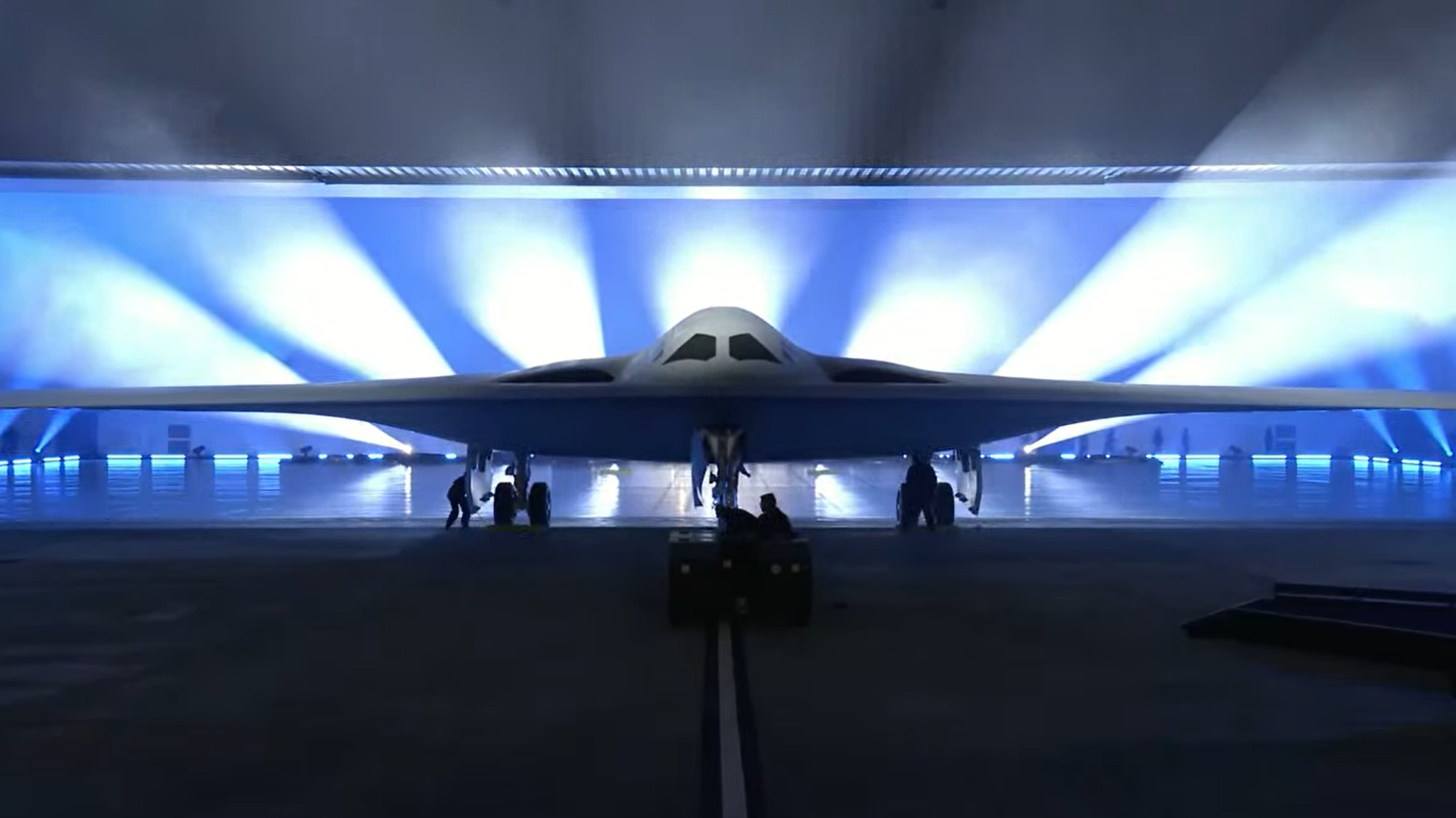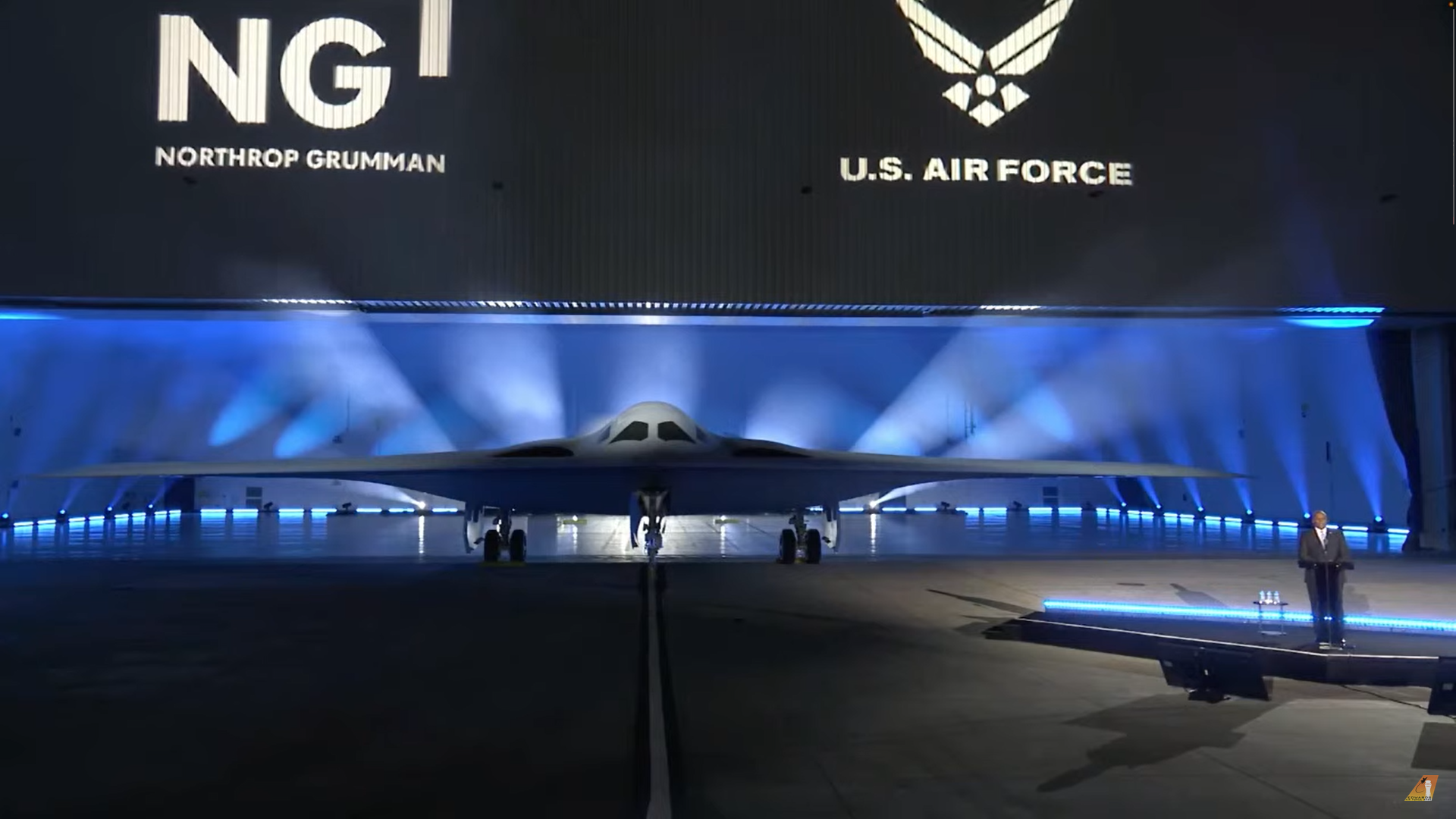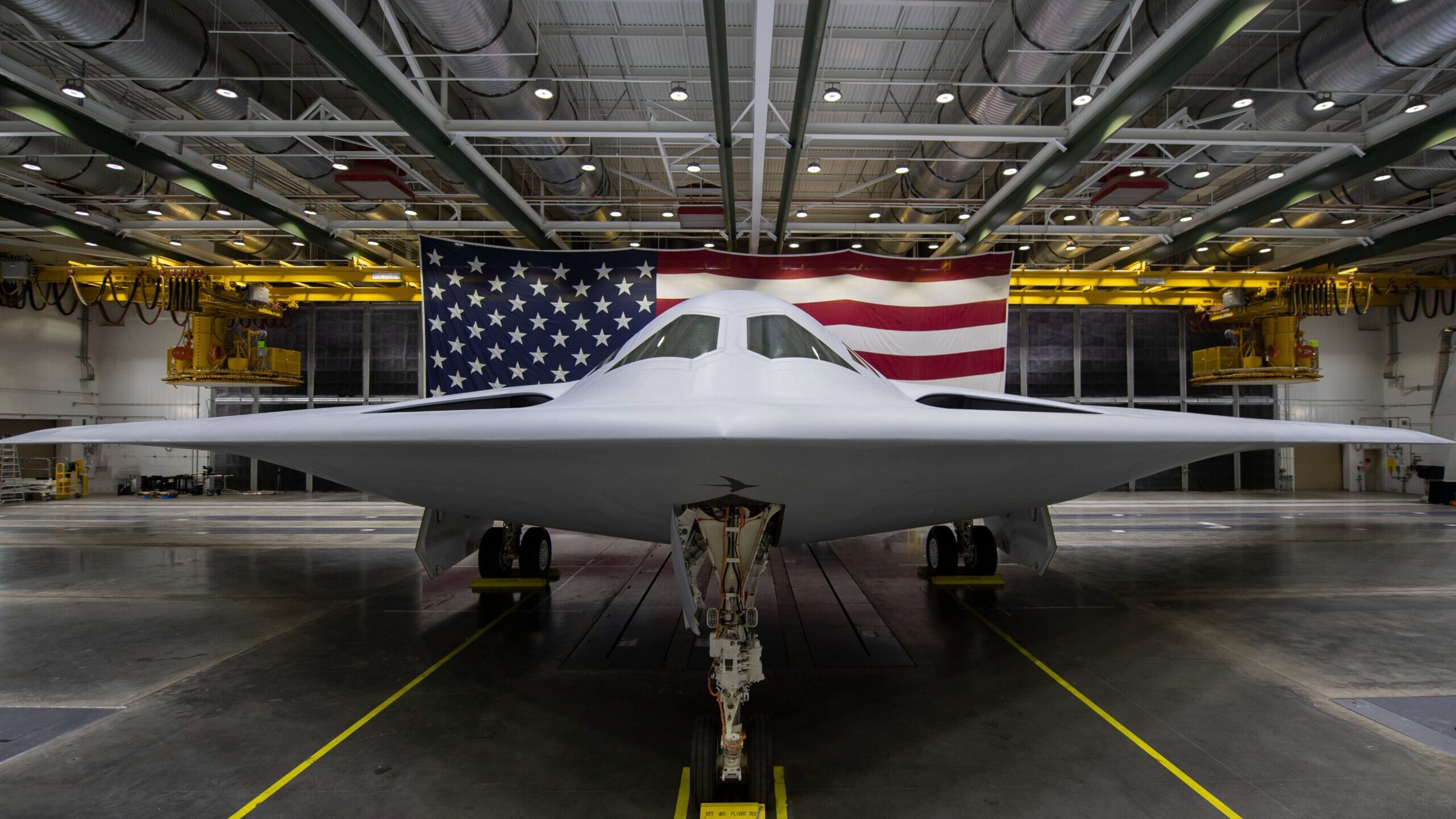
Northrop Grumman unveiled the B-21 stealth bomber at a livestreamed ceremony on Dec. 2, 2022. (Northrop Grumman/screengrab)
PALMDALE, Calif. — Northrop Grumman finally pulled the cover off the first B-21 Raider aircraft, revealing the Air Force’s newest stealth bomber to the world during a once-in-a-generation roll out ceremony today.
After brief opening remarks by Northrop CEO Kathy Warden, who said the plane “will be the backbone of US air power” and represented a “new era in technology for national defense,” the gauzy silver veil was literally withdrawn to swelling orchestral music.
Backlit by blue and white lights, the B-21 then was towed halfway out of its hangar, likely to ensure that sensitive design elements in the back of the aircraft remain hidden. A flying wing similar to the B-2 — but perhaps appearing more like a flying saucer out of a 1950s sci-fi movie — the B-21 design exhibited some marked differences from its immediate predecessor, including inlets that are flusher to the body of the jet and smaller windows.
The new bomber already boasted Air Force markings, including a “0001” indicating its status as first of a series and the “ED” for its future home — Edwards Air Force Base.
Secretary of Defense Lloyd Austin, speaking in front of the plane and somewhat dwarfed by it, touted its capabilities.
“The B-21 looks imposing, but what’s under the frame and the space-age coatings is even more impressive,” he said, highlighting the bomber’s range, stealth and durability. “Even the most sophisticated air defense systems will struggle to detect the B-21 in the sky.”
Speaking of the aircraft’s range, Austin hinted that it could be even longer than the B-2s, B-1s and B-52s that make up the Air Force’s legacy bomber fleet. “No other long-range bomber can match its efficiency. It won’t need to be based in-theater, and it won’t need logistical support to hold any target at risk,” he said.
Echoing Warden’s remarks to Breaking Defense before the ceremony, Austin highlighted the technological adaptability of the bomber, designed to be easily upgraded.
“The Raider is designed to deliver both conventional and nuclear munitions with formidable precision,” he said. “So as the United States continues to innovate, this bomber will be able to defend our country with weapons that haven’t even been invented yet.”
The B-21 seen today is the first test article to roll off the production line, with five other bombers in some stage of production at Northrop’s facilities at the Air Force’s secretive Plant 42. After wrapping up ground testing, which will include powering its systems on and off and conducting taxi tests, the B-21 is scheduled to make its first flight in 2023 before being transferred to Edwards Air Force Base some 20 miles northeast.

Secretary of Defense Lloyd Austin speaks in front of the newly revealed B-21 stealth bomber on Dec. 2, 2022. (Northrop Grumman/screengrab)
About 600 people attended the historic event, including Air Force Secretary Frank Kendall and a lineup of House and Senate lawmakers.
Many analysts had predicted that the B-21 would look like a slightly smaller B-2, and the long-awaited reveal didn’t deviate much from those forecasts.
“In line with expectations, it looks a lot like a scaled down B-2, with a few modifications,” said Richard Aboulafia, an aerospace analyst with AeroDynamic Advisory. “Most of the progress in aerospace over the last 35 years has been with subsystems, materials, and connectivity, so that makes sense. It’s interesting that the flying wing concept created in the 1940s is still relevant today.”
Although the roll out of the B-21 answers some questions, a significant portion of the B-21’s design — even basic information about its engine — remains shrouded in mystery, said Jeremiah Gertler, an aerospace analyst with the Teal Group.
“We don’t know a lot today that we didn’t know yesterday. The inlets look narrow and the belly looks deep, and the size appears closer to the B-2 then many people were expecting,” he said. “But we don’t know how many engines it has or what its range is or what its wing planform looks like, because we’ve only been allowed to see it from one angle. So it’s not yet clear whether, physically, it’s a B-21 or a B-2.1.”
RELATED: Ahead of B-21 Raider reveal, Northrop CEO touts tech you won’t see
For more than seven years, Northrop could only hint at the aircraft’s design in digital renderings and promotional images in which the B-21 was shown draped in a drop cloth to conceal its features — a depiction made famous in a commercial aired during the 2015 Super Bowl just months before Northrop beat out a Boeing-Lockheed Martin team to win the Long Range Strike Bomber contract.
During a roundtable with reporters before the rollout, Warden said Northrop had created “thousands” of design iterations in a digital environment before choosing the final design of the aircraft.
Almost all details about the B-21’s performance remain highly guarded by the Pentagon, which wants to protect its technological advances from China and Russia.
Although the B-21 was designed to either be operated by a human or flown without a pilot in the cockpit, the Air Force has not laid out a plan or timeline to use the aircraft in an unmanned capacity, with Andrew Hunter, the service’s top acquisition official, telling reporters today that fielding a crewed aircraft was the “primary focus.”
Over the lifespan of the program, the Air Force plans on buying at least 100 B-21s at an average procurement unit cost of $692 million per plane in 2022 dollars. That sum includes a B-21 as well as training, spares and support equipment.
RELATED: As classified B-21 bomber nears flight, secret facility sees more curious ‘probing’
The service begins funding low-rate initial production of the new bomber in fiscal 2023, spending $1.7 billion in procurement funding on top of $3.3 billion to carry on research and development activities. Air Force officials have declined to comment on how many B-21s that sum will buy.
As for the B-21 on display today, Warden said, “The next time you see this plane, it’ll be in the air.”

Unveiled Dec. 2, 2022, the B-21 Raider will be a dual-capable, penetrating-strike stealth bomber capable of delivering both conventional and nuclear munitions. (U.S. Air Force photo)
Breaking Defense’s Lee Ferran contributed to this report.






















